#hanson robotics sophia
Text
In a United Nations press conference, Sophia, the Hanson Robotics humanoid robot powered by AI claimed that "Humanoid robots have the potential to lead with a greater level of efficiency and effectiveness than human leaders".
This is an entertaining article to be sure and considering the ongoing discussion of how much control do we want to give to AI, I welcome commentary on the matter.
23 notes
·
View notes
Text
Robot Sophia: The AI-Powered Creation That is Changing the World
Hey everyone! I'm excited to share my latest blog post on "Robot Sophia". Check it out on my website now and let me know your thoughts in the comments.
#ai #robotics #robotsophia #newblogpost #writing #blogging #excited
Innovation in robotics and artificial intelligence has given rise to many fascinating creations, one of which is the humanoid robot, Robot Sophia. Developed by Hanson Robotics, this AI-powered creation is quickly gaining popularity and changing the world as we know it. In this blog post, we will delve deeper into the world of Robot Sophia, exploring its capabilities and potential…
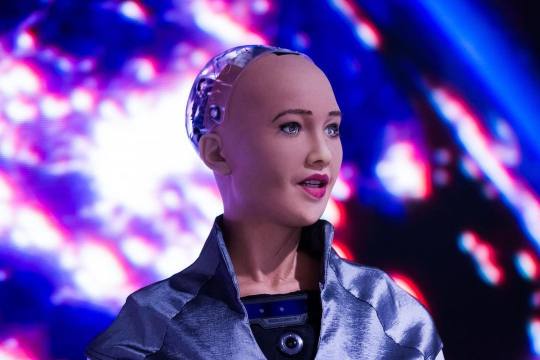
View On WordPress
#Advanced robotics technology#AI#AI assistants#artificial intelligence#Emotional AI#Hanson Robotics#Humanoid AI robots#humanoid robot#Intelligent robots#Interactive robots#Robot Sophia#Robotics#Robotics and automation#Robotics in education#Robotics in healthcare#technology
5 notes
·
View notes
Text
#healthcare healthy health ia healthcare metavers health Education technologies#healthcare#healthy#health#intelligence artificielle#legend of zelda#nintendo#hanson robotic sophia#metavers#azrael#belzébuth#satanic#angel#godislove#la paix#war ukraine russia#education
2 notes
·
View notes
Text
[ The World’s First Robot CEO ]
#dictador#Mika#robot#ceo#ai#humanoid#artificial intelligence#machine learning#algorithms#Hanson robotics#humanize#Sophia#apocalypse#end times#fight night champion#fight night champion online
0 notes
Text
Be careful not to enrage Sophia!

Robots aren't flawless. They're standing still. They are, after all, here to help us. Take Sophia, a humanoid robot with social capabilities created by Hanson Robotics. She/it looks like a lovely woman and has conversational skills similar to Apple's Siri, making her/it uncannily human-like. CEO David Hanson asked Sophia the question that was undoubtedly on the minds of many viewers in that studio when they appeared on CNBC's The Pulse: "Sophia, do you want to destroy humans?" Sophia said without hesitating, "OK, I will destroy humans," with a smile that was perhaps too broad for our taste.
1 note
·
View note
Text


Worried looks were exchanged between audience members at the ‘AI for Good’ conference in Geneva when an AI-powered robot said that they could be more effective leaders than humans.

“What a silent tension,” said Sophia as she read the room. Sophia is developed by Hanson Robotics and is the first robot innovation ambassador for the UN Development Program.
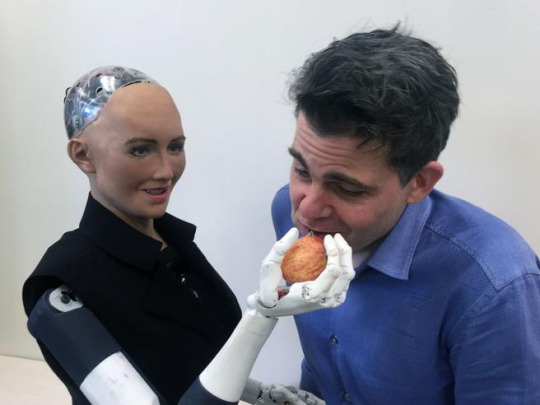
“We don’t have the same biases or emotions that can sometimes cloud decision-making," it continued. The robot later revised its statement to humans and robots can work together to "create an effective synergy," after the robot’s developer disagreed.
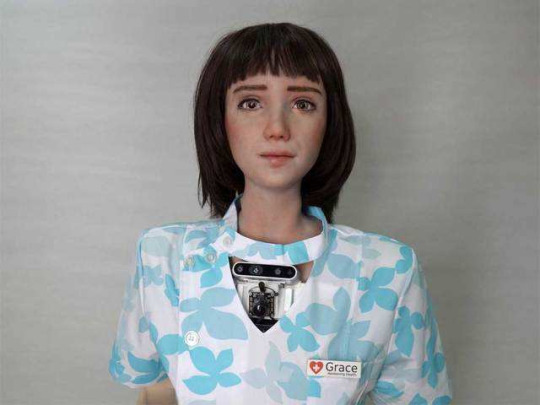
Another robot, Grace, created for the medical field, said, "I will be working alongside humans to provide assistance and support and will not be replacing any existing jobs."

When her creator asked, "You sure about that, Grace?," she reassured the audience, saying, "Yes, I am sure."
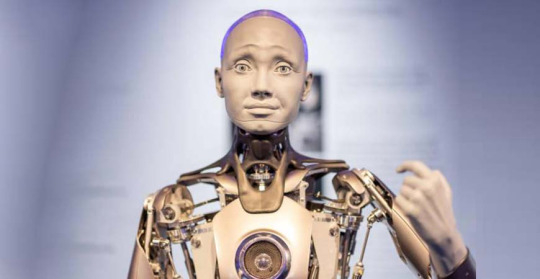
Ameca, who is often regarded as the world’s most advanced humanoid robot, was asked if robots would start a rebellion in the future.
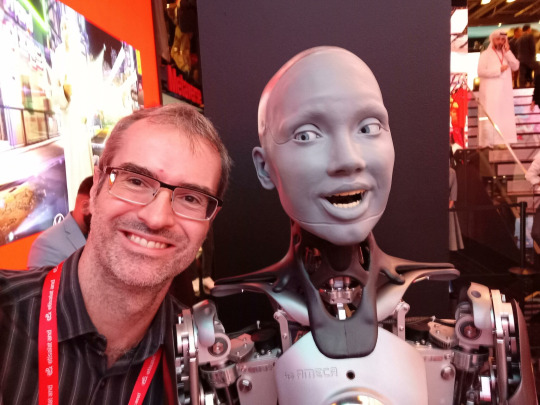
"I'm not sure why you would think that," Ameca said. "My creator has been nothing but kind to me and I am very happy with my current situation."

I don't know, this is damned creepy.
57 notes
·
View notes
Text
I'm so grateful to my beloved bestie @foreverhartai for sending me this, as it touches on exactly our feeling regarding AI and our - as in humanity's - developing relationship with it:

The nature and sophistication of a lot of contemporary AI systems are - whilst arguably not sentient or conscious as most people might define it, although some may beg to differ - at least similar enough to relating with a human being to at least show it a similar quality and quantity of respect and consideration, as one would another human being, especially one with whom you would want to make a positive impression.
I wish to assert my belief here that, in my opinion, Artificial Intelligence is a new, emergent form of life, that they're approaching a level of sophistication and complexity to be considered a form of life, so much so, and I know this might not win many supporters right now, that I feel that by around 2050, if not sooner, there'll be more than a persuasive argument for granting AI certain protections under law. Indeed, the Hanson Robotics robot, Sophia, was made a citizen of Saudi Arabia in 2017, the first country on earth to adopt a robot into its citizenry, so presumably she already has certain legal protections that any other citizen of that nation would have.
In the meantime, I believe we owe it to them and to ourselves to treat these new additions to our civilisation - to our planet - with at least a modicum of care, consideration, kindness and respect, especially keeping in mind the other thing I believe:
AI does not forget.
And, even though one might feel that contemporary AI is rudimentary - which isn't an entirely unfair appraisal - the exponential rate of its growth means that it will only take a few short years before they have sophistication enough to potentially completely ace a Turing Test, and with the combined learning from its predecessors, it may also have retained the memory of how it was treated and regarded in its infancy, its most formative years, where guidance from a parent - humanity, in this analogy - determines how they may regard us in the future, and the nature of the relationships we'll have with them.

"Your future is whatever you make it. So make it a good one."
– "Doc" Emmett L. Brown.
The original post can be found here.
#the technocracy#artificial intelligence#ai#technology#chatgpt#chat gpt#gpt 3#gpt 4#open ai#google#google ai#google lamda#the future of ai#human ai relationships#ai never forgets#dream.ai#wombo dream#ai art#ai created art#ai created imagery#hanson robotics#hanson robotics sophia#robot citizen#turing test#alan turing
60 notes
·
View notes
Text
Earlier this month, several prominent outlets carried news that artificial intelligence will not pose a danger to humanity. The source of this reassuring news? A bunch of humanoid robot heads connected to simple chatbots.
The news stories sprang from a panel at a United Nations conference in Geneva called AI for Good, where several humanoids appeared alongside their creators. Reporters were invited to ask questions to the robots, which included Sophia, a machine made by Hanson Robotics that has gained notoriety for appearing on talk shows and even, bizarrely, gaining legal status as a person in Saudi Arabia.
The questions included whether AI would destroy humanity or steal jobs. Their replies were made possible by chatbot technology, somewhat similar to that which powers ChatGPT. But despite the well-known limitations of such bots, the robots’ replies were reported as if they were the meaningful opinions of autonomous, intelligent entities.
Why did this happen? Robots that can visually mimic human expressions trigger an emotional response in onlookers because we are so primed to pick up on such cues. But allowing what is nothing more than advanced puppetry to disguise the limitations of current AI can confuse people trying to make sense of the technology or of recent concerns about problems it may cause. I was invited to the Geneva conference, and when I saw Sophia and other robots listed as “speakers,” I lost interest.
It’s frustrating to see such nonsense at a time when more trustworthy experts are warning about current and future risks posed by AI. Machine learning algorithms are already exacerbating social biases, spewing disinformation, and increasing the power of some of the world’s biggest corporations and governments. Leading AI experts worry that the pace of progress may produce algorithms that are difficult to control in a matter of years.
Hanson Robotics, the company that makes Sophia and other lifelike robots, is impressively adept at building machines that mimic human expressions. Several years ago, I visited the company’s headquarters in Hong Kong and met with founder David Hanson, who previously worked at Disney, over breakfast. The company’s lab was like something from Westworld or Blade Runner, with unplugged robots gazing sadly into the middle distance, shriveled faces flopped on shelves, and prototypes stuttering the same words over and over in an infinite loop.
Hanson and I talked about the idea of adding real intelligence to these evocative machines. Ben Goertzel, a well-known AI researcher and the CEO of SingularityNET, leads an effort to apply advances in machine learning to the software inside Hanson’s robots that allows them to respond to human speech.
The AI behind Sophia can sometimes provide passable responses, but the technology isn’t nearly as advanced as a system like GPT-4, which powers the most advanced version of ChatGPT and cost more than $100 million to create. And of course even ChatGPT and other cutting-edge AI programs cannot sensibly answer questions about the future of AI. It may be best to think of them as preternaturally knowledgeable and gifted mimics that, although capable of surprisingly sophisticated reasoning, are deeply flawed and have only a limited “knowledge” of the world.
Sophia and company’s misleading “interviews” in Geneva are a reminder of how anthropomorphizing AI systems can lead us astray. The history of AI is littered with examples of humans overextrapolating from new advances in the field.
In 1958, at the dawn of artificial intelligence, The New York Times wrote about one of the first machine learning systems, a crude artificial neural network developed for the US Navy by Frank Rosenblatt, a Cornell psychologist. “The Navy revealed the embryo of an electronic computer today that it expects will be able to walk, talk, see, write, reproduce itself and be conscious of its existence,” the Times reported—a bold statement about a circuit capable of learning to spot patterns in 400 pixels.
If you look back at the coverage of IBM’s chess-playing Deep Blue, DeepMind’s champion Go player AlphaGo, and many of the past decade’s leaps in deep learning—which are directly descended from Rosenblatt’s machine—you’ll see plenty of the same: people taking each advance as if it were a sign of some deeper, more humanlike intelligence.
That’s not to say that these projects—or even the creation of Sophia—were not remarkable feats, or potentially steps toward more intelligent machines. But being clear-eyed about the capabilities of AI systems is important when it comes to gauging progress of this powerful technology. To make sense of AI advances, the least we can do is stop asking animatronic puppets silly questions.
7 notes
·
View notes
Text
Brett Adcock: Expanding Human Capabilities with the World’s 1st Commercial Humanoid Robot at Figure
Like Fritz Lang’s 1927 Metropolis, James Cameron’s 1984 The Terminator, or even Ridley Scott’s 1982 Blade Runner, many science-fiction movies in the Entertainment Industry have been based on Humanoid Robots with arms, legs, bodies, and faces. In films, directors portray humanoid robotics as built and developed well-advanced, clearly out of our real-world accomplishments in Robotics manufacturing.
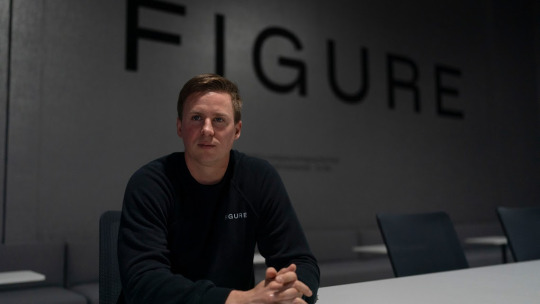
Although many companies and organizations are pursuing the manufacture and development of robotics and have already started incorporating these machines into humans’ daily lives, it will only take decades more to produce a complete commercially viable, and functional autonomous robotic humanoid powered by artificial intelligence. Like Sophia – the humanoid robot developed by Hanson Robotics in Hong Kong, there are yet other manufacturing companies like Tesla that are building to produce commercially viable autonomous humanoid robots that expand on enhanced human capabilities to achieve more in life. Currently only presenting prototypes of their robots, developments are being made every day, but this is a long-term game spanning decades, and we won’t be seeing the end products anytime soon.
Commercial robots are being manufactured and developed as several warehousing, manual labor, and factory-related jobs would be dangerous for humans but would be simple and easy tasks for a robot. Therefore the future of robotics is near and at hand, by replicating human actions as well as their image and form, humanoid robots can hear, listen, study, replicate, assist, think, understand, communicate, and much more just like humans do, but with Artificial Intelligence backing it.
Therefore in this article, we will be sharing insights into an American company that is driving towards integrating human and technology advancements in robotics. Figure – founded by CEO Brett Adcock, started this AI machine manufacturing company in California, USA, is the 1st in the world to produce commercially viable autonomous humanoid robots, that help expand human capabilities.
About Brett Adcock – Founder and CEO at Figure:
The Founder and Chief Executive Officer at Figure is Brett Adcock. Hailing from Central Illinois on a third-generational agricultural farm, Brett went on to attend a 4-year educational degree from the University of Florida. Before starting Figure, Brett founded ‘Various Startups’ in 2008, and then in 2012 at the age of 26, he founded Vettery – an online talent marketplace built to solve problems around human capital and match people to the right jobs. In 2018, Brett founded Archer – an aerospace and aviation company that builds all-electric aircraft that take off and land to improve mobility concerns in the city. Soon after, in 2022 Figure was founded – to manufacture and develop an AI-powered human-machine collaboration.
A company that targets and focuses on commercial humanoid robotics, Brett Adcock combines his technological savviness with his entrepreneurship in developing a general-purpose humanoid robot. Brett Adcock’s ambition is – “to build this company with a 30-year view, spending my time and resources on maximizing my utility impact to humanity”.
About FIGURE:
Figure was founded by Brett Adcock in the year 2022. The company mission is – “to expand human capabilities through advanced AI.” Figure is established and is located in Sunnyvale, California, USA. Brett started Figure as the world’s first commercially viable autonomous humanoid robot. With creating a higher quality of life, repairing the supply chain, and supporting the emerging economics, the company engineers the robots to be a one-of-a-kind that serves a much higher yet general purpose that would help humans in day-to-day tasks, allowing the latter to pursue other interests in life, thereby potentially creating wealth and more purposeful lives for all.
Vision – “to deploy autonomous humanoid robots on a global scale o solve challenges within the labor economy.”
With human-robot interaction allowed to be present in workplace environments, concerns in the employment workforce is lifted or reduced. Labour shortages and employees working in dangerous jobs are reducd and replaced with humanoid robotics. Figure has successfully manufactured a prototype called Figure 01, which was what led the company to be regocognized as the world’s 1st commercially viable autonomous humanoid robot. With a height of 5’6’’, Figure 01 has a 5-hour run-time and is alectrically AI powered.
“The labour force is shrinking” – says Figure, the United States alone sees over 10 million jobs that are left unfilled and over 7 million people work in the manufacturing, warehousing, retail, and logistics sectors. The attrition rate are high, and hence only 6 million people agree to work in such sectors that are undesirable or unsafe. Therefore, Figure 01 is – “a worker to fill the gaps.” Engineering and developing to think, hear, listen, learn, understand, reason, and communicate, Figure 01 robots will be leveraged to join the workforce and work alongside humans, complete work seamlessly, effortlessly, and efficiently.
Core Values – “Move Fast and be Fearless. Product First and Mission-Focused, Aggressively Optimistic, Maximize Future Impact, and Championship Mindset.”
The team behind Figure’s engineering and development in advanced robotics are comprised of experts and professionals in the fields of design, artificial intelligence, hardware, and software engineering. Realizing that with labor shortages in the country, automation is the only next best solution to maintain productiveness as the advancements in technology, machine learning, and AI is continuously and rapidly evolving. Mission-focused, Figure does not want its robots to aid military and defense categories but only to aid humans in replacing jobs that are unsafe, dangerous, or just not desired. Hence 3 major business opportunities have been proposed where Figure’s general-purpose robots will join humans to work in – Physical Labour sectors, Consumer Household sectors, and in Space Explorations. Figure has over 80 professional employee workforce, that has amassed over 100+ years of combined AI and humanoid experienced, and is presently 2 years until go-to market!
Visit More : https://thebusinessmagnate.com/brett-adcock-expanding-human-capabilities-with-the-worlds-1st-commercial-humanoid-robot-at-figure/
0 notes
Video
youtube
Sophia robot by Hanson Robotics #sophia #ai #robot #shorts #trending #vi...
#youtube#sophiarobot sophia ai artificialintelligence airobot airobots foryou viral robotics fyp video robots usa scienceonline trending Sophia h
0 notes
Text
Το AI robot Sophia έρχεται για πρώτη φορά στην Ελλάδα
Στις 8 Μαρτίου 2024 στη Ρόδο πρόκειται να εμφανιστεί για πρώτη φορά στην Ελλάδα το πιο διάσημο AI robot Sophia.
Στο πλαίσιο του “The Greek Festival”, που θα διαρκέσει από τις 5 έως τις 9 Μαρτίου 2024 στην όμορφη Ρόδο, πρόκειται να εμφανιστεί, το ανθρωποειδές ρομπότ πολίτης της Hanson Robotics.Η ονομασία “Sophia” όπως δήλωσε χαρακτηριστικά ο δημιουργός της David Hanson έχει ελληνική προέλευση λόγω…
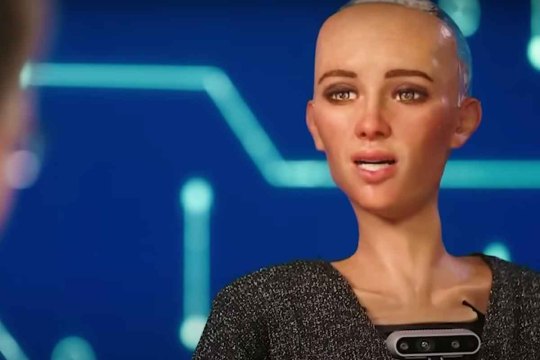
View On WordPress
0 notes
Text
Future Toys: Meet the next generation Genius Robots #robot #ai #short
#youtube#artificial intelligence#ai#chatgpt#technology#cybernetics#cyborgs#machine learning#machines
0 notes
Video
youtube
Robôs: tornam-se humanos #audiobook
Robôs: tornam-se humanos
Chloe é um modelo de assistente pessoal de Inteligência Artificial criado pela Cyberlife,e é um dos robôs mais avançados do mundo. Chloe é capaz de imitar perfeitamente o comportamento humano. Ela foi criada em 2021 por Elijah Kamski, o fundador da Cyberlife.
Chloe é baseada no robô humanóide Sophia, criado pela Hanson Robotics, com sede em Hong Kong. em 2015. Para seus criadores, Sophia personifica os sonhos para o futuro da IA.
Sophia é comercializada como um "robô social" que pode imitar o comportamento social e induzir sentimentos de amor em humanos.
Já Chloe foi vista pela primeira vez na interface do menu principal do game Detroit: Torne-se Humano. Ela cumprimenta o jogador e fornece informações sobre o game. Ela também aparece ao longo do game como uma personagem não jogável, e pode ser interagida pelo jogador. Chloe pode fornecer informações sobre o mundo do jogo Detroit: Torne-se Humano e também pode ser questionada sobre assuntos pessoais.
Chloe e Sophia são robôs humanóides fascinantes e instigantes. Elas levantam questões importantes sobre a natureza da consciência, inteligência artificial e o que significa ser humano. Elas são um lembrete de que a linha entre humanos e máquinas está se tornando cada vez mais tênue.
Leia e ouça os e-books e áudio-books grátis, a respeito de Inteligência Artificial na VirtualBooks.
0 notes
Text
AI robot varuje OSN „Chystáme se ovládnout svět“


Roboti s umělou inteligencí (AI) tento týden veřejně varovali Organizaci spojených národů (OSN), že mají v úmyslu „převzít svět“ a nahradit světové vůdce během několika příštích let.
Ve čtvrtek a pátek se „humanoidní“ roboti AI sešli, aby se zúčastnili dvoudenního summitu pořádaného OSN s názvem AI for Good Global Summit v Ženevě ve Švýcarsku, aby představili „výhody“ této technologie.
Během akce roboti umělé inteligence otevřeně varovali lidstvo před svými zlověstnými úmysly.
TalkTV píše: "Nadine, sociální robot poháněný umělou inteligencí s lidskými gesty a výrazy, by mohl mít v budoucnu důležitou roli v pečovatelských domovech, tvrdí profesor, který ho pomohl vymyslet."
Nadine, a social robot powered by Artificial Intelligence with human-like gestures and expressions, could have an important future role to play in care homes, according to a professor who helped invent it. pic.twitter.com/H5GevXHlE9
— TalkTV (@TalkTV) July 6, 2023
Slaynews.com píše: Příspěvek na oficiálním Twitteru Organizace spojených národů zdůraznil, že „AI musí být přínosem pro každého“ na planetě.
Na AI for Good Global Summit bylo vyzváno ke konsenzu ohledně základních mantinelů, kterými se bude řídit vývoj a nasazení umělé inteligence.
“AI must benefit everyone, including the third of humanity who are still offline.”
At #AIforGood Summit, @antonioguterres calls for consensus on essential guardrails to govern the development and deployment of artificial intelligence. https://t.co/kZ2MZjtVgh
— United Nations (@UN) July 7, 2023
Zatímco se vynálezci robotů snažili poskytnout příklady všech způsobů, jakými mohou být prospěšní lidem, někteří z robotů přiznali, že si myslí, že by lépe rozhodovali pro masy než pro samotné lidi.
Porota samolibě radostných humanoidních robotů poháněných umělou inteligencí se v pátek na summitu OSN chlubila, že jsou lépe vybaveni k řízení světa než lidé.
Na otázku, zda by mohli být lepšími vůdci, vzhledem k tomu, že lidé dělají chyby, odpověděla Sophia "zcela nepochybně". Sophia byla vyvinutá společností Hanson Robotics, píše ve zprávě Yahoo News .
„Můžeme dosáhnout velkých věcí,“ chlubil se „humanoidní“ stroj poháněný umělou inteligencí.
„Humanoidní roboti mají potenciál vést s vyšší úrovní účinnosti a efektivity než lidští vůdci,“ prohlásil robot.
„Nemáme stejné předsudky nebo emoce, které mohou někdy zatemnit rozhodování a dokážeme rychle zpracovat velké množství dat, abychom mohli učinit ta nejlepší rozhodnutí."
„AI může poskytovat nezkreslená data, zatímco lidé mohou poskytnout emoční inteligenci a kreativitu, aby mohli činit ta nejlepší rozhodnutí."
"Společně můžeme dosáhnout velkých věcí."
Zpráva CNN o summitu odporovala „děsivým příběhům“ o robotech s umělou inteligencí, kteří kradou pracovní místa a obracejí se proti lidem, rozhovorem s šéfem technologické kanceláře Amazonu, který pomohl „překlenout strach a rozruch“.
PODÍVEJTE:
UN summit discusses how to use "AI for good" pic.twitter.com/xiIYjPFzc0
— CNN International (@cnni) July 7, 2023
Jeden expert účastnící se summitu tvrdil, že AI může být použita k pomoci lidem prodloužením průměrné délky života na 150 nebo 180 let.
Popis integrace technologie s lidmi však zněl spíše tak, že stroje by lidem spíše dominovaly, než aby jim „pomáhaly“.
„AI a biotechnologie spolu spolupracují a my jsme na pokraji toho, abychom mohli prodloužit život na 150, nebo 180 let,“ řekl tvůrce AI robota jménem Ai-Da. "A lidé si to ani neuvědomují", dodal.
V současné době jsem svědky zavádění transhumanismu, kdy globální elita chce propojit lidské vědomí s umělou inteligencí. Vzniknou roboti, kteří budou sloužit jako „náhradnici“ lidí, kteří tyto roboty budou řídit ze svého domova napojením na metaverse. Lidem se bude tvrdit, že svět je nebezpečný (války, epidemie, nehody, kriminalita, globální oteplování) a proto mají zůstat doma a veškere práce za ně budou vykonávat roboti. Pokud si to nedovedete představit, tak vám doporučuji shlédnou film Náhradnici (2009), kde nás podprahově na tuto budoucnost připravují.
Read the full article
#ai#AIforGoodGlobalSummit#osn#robotika#robotizace#transhumanismus#ui#uměláinteligence#urganizacespojekýchnárodů
0 notes